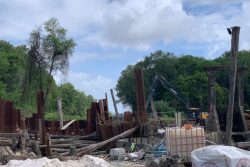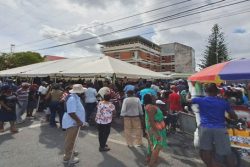A part of the Amerindian heritage that is very well known, highly visible and accessible is the literature. This includes the Romantic, the historical and the actual. The literature of Guyana was started and has been forever coloured by the prose writings of Walter Ralegh (not his poetry, which belongs to an entirely different English tradition). His The Discovery of Guyana (short modernised title) set off an endless succession of literature based on El Dorado and the gilded Amerindian prince. That has been an inexhaustible source of inspiration and imagination for Guyanese writers that has reappeared in the literature and has been a popular theme in tourism.
Written accounts at the very root of written Guianese history, the very ancestors of Guianese literature, have their origin in the Amerindian presence and European encounters with it. This literature in its wider interpretations will include the historical and the anthropological documentation  and commentary. It consists of the various works of the likes of Everard im Thurn, Rev William Brett, William Hillhouse and Walter Roth, followed by contemporary authors such as Prof Emeritus Mary Noel Menezes and Dr Audrey Butt-Colson. These cover a vast store of work that can be called Guyanese Amerindian literature because of their subjects. In addition to the works of Prof Menezes, who is a historian, other work emerged from the University of Guyana of a multi-disciplinary nature and written by other historians, cultural anthropologists and linguists including Dr Jannette Bulkan, Joel Benjamin, Anna Benjamin, Dr Desrey Fox, Laureen Pierre, Walter Edwards, Ian Robertson and Canon John Peter Bennett.
and commentary. It consists of the various works of the likes of Everard im Thurn, Rev William Brett, William Hillhouse and Walter Roth, followed by contemporary authors such as Prof Emeritus Mary Noel Menezes and Dr Audrey Butt-Colson. These cover a vast store of work that can be called Guyanese Amerindian literature because of their subjects. In addition to the works of Prof Menezes, who is a historian, other work emerged from the University of Guyana of a multi-disciplinary nature and written by other historians, cultural anthropologists and linguists including Dr Jannette Bulkan, Joel Benjamin, Anna Benjamin, Dr Desrey Fox, Laureen Pierre, Walter Edwards, Ian Robertson and Canon John Peter Bennett.
Of course, when one thinks of Guyanese literature, one will most likely mean the creative or imaginative writings in fiction, poetry and drama. These include quite a corpus of those whose plots, characters, themes and ethos draw from the Amerindian presence. The national literature is immensely enriched by these volumes led by the works of Wilson Harris, Pauline Melville, Jan Carew, David Dabydeen, Mark McWatt, AJ Seymour, Ian McDonald, Egbert Martin (Leo) and Michael Gilkes.
This literature varies considerably in content and preoccupations, but the greatest value of it is that the best of it contributes much more to Guyanese literature than the mere appearance of Amerindian characters or plots. The authors have created a literature influenced by concepts and styles that interrogate Amerindian content in a very profound fashion. Harris’s originality in forms of fiction is well known and he has created several works ranging from his best known, Palace of the Peacock, to The Carnival Trilogy and several others in between. Among the most startling of the fiction is Pauline Melville’s The Ventriloquist’s Tale which delves deeper than any other into the Amerindian psyche and cosmos, exploring mythology and the tragedy of cultural exclusiveness within the societies and the tragedy of the intrusion of outside cultures. Dabydeen’s interest is Harrisian in Our Lady of Demerara and in social and cultural healing and rebirth in Molly and the Muslim Stick. Both come under the curative influence of the Amerindian heartland, which he contrasts with the urban and metropolitan pollution and grime of England’s Coventry and Accrington.
This literature is brilliantly steeped in or reflective of the culture while being written, except in a few instances such as Melville, by non-Amerindians. But the heritage also includes literature created by the indigenous people and arising from their traditions. The reference here is to the large corpus of myths, legends and folk tales that are a part of Guyanese oral literature. Even here, there are contributions made by outsiders like AJ Seymour and Jan Carew who have interpreted Amerindian legends in poetry and prose. But the tales they tell are indigenous and explain many of the beliefs. The Coming of Amalivaca by Carew retells an important account of a legend that stands out among Amerindian contributions to Guyanese literature, as it does to the indigenous ethos. In similar fashion, Seymour’s verse is based on the origin of the name of Guyana’s most famous waterfall, in The Legend of Kaieteur. This story of nobility and sacrifice seeks to explain some of the mystery that surrounds this mighty waterfall.
However, several Amerindian folktales have been collected, recorded and documented and the volumes add to the literature. The collectors include Rev William Brett in the nineteenth century as well as twentieth century researchers. These include Odeen Ishmael who has published some three volumes, and Dorothy Bland St Aubyn who reproduced a number of tales in a Demerara Mutual Life calendar in 1995. All put together these volumes are priceless in what they reveal of this brand of oral literature, in spite of many obvious editorial interferences and adaptations practised by the collectors in several instances.
While there are huge deficiencies in what has survived in indigenous performing arts, the fine arts tell a very different story. The Amerindian contribution to Guyanese visual arts is exceedingly vibrant and the most unique in the Caribbean. The leading artists in a new wave of artistic product in painting and sculpture are members of the Lokono group George Simon and Oswald Hussein, along with Lynus Clenkian and Telford Taylor, while Winslow Craig works outside of that circle. This is art inspired by and expressive of the spiritual and traditional beliefs. Craig’s work is a bit less of this persuasion, but the others are guided in their work by the Lokono (Arawak) traditions, which since the late 1980s have been driving an outstanding innovative thrust in Guyanese art.
While Hussein is the most impressive sculptor working in this vein, Simon is outstanding both within and without it. Simon’s latest works transcend the Lokono although still extensions of the profoundly spiritual quality. He has embraced mythology and traditions including the Hindu, Haitian and African spiritual beliefs in Guyana. Along with Craig (a sculptor) and Hussein, Simon’s art is the most important recent examples of the Amerindian artistic heritage.
The Amerindian heritage, particularly in a cultural sense, is as widespread as it is deep and profound in Guyanese culture and society. It is to be found in numerous corners of Guyanese customs, art and daily life, as well as in traditions almost lost in the interior. It is so important to the national identity that the Amerindian heritage is indivisible from Guyanese nationhood.






